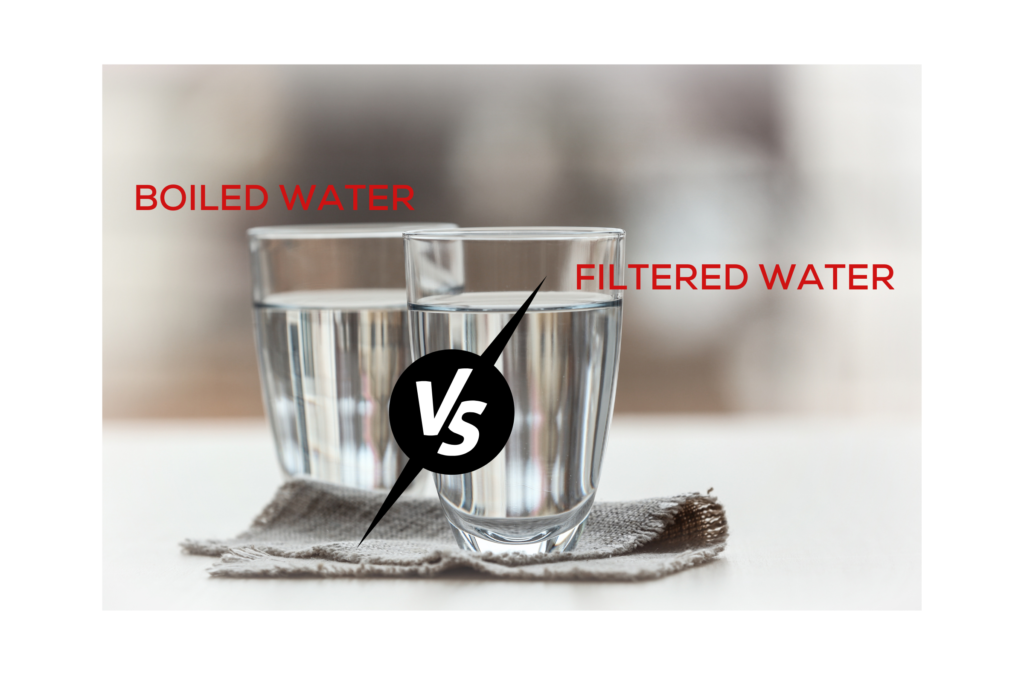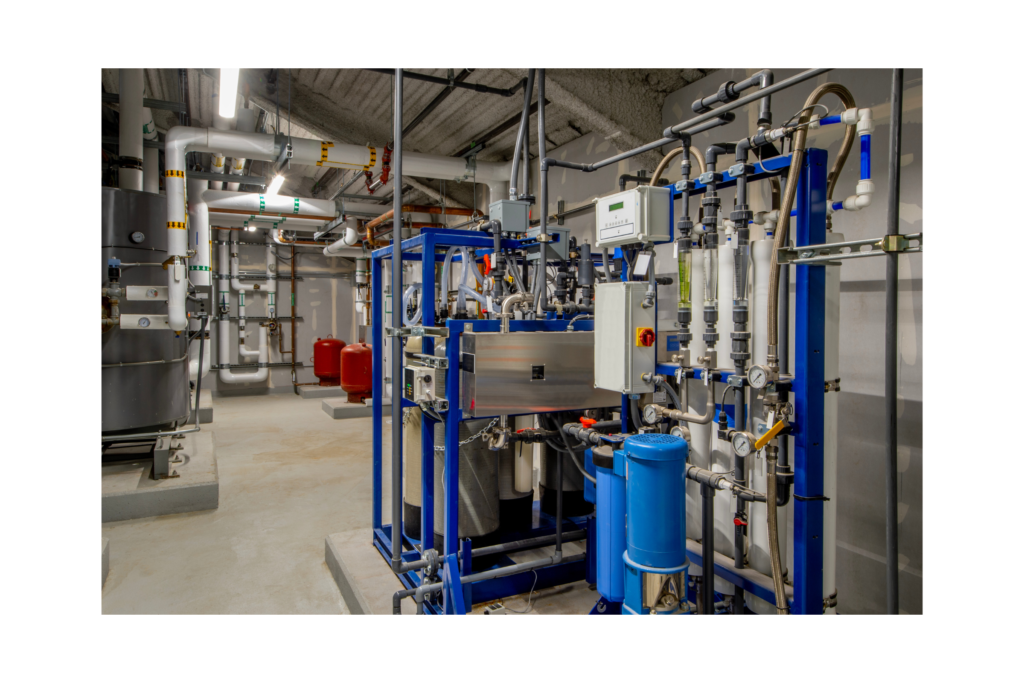Is Boiled Water the Same as Filtered Water? (No! 8 Pollutants Missed)
Have you ever wondered whether or not boiled water is the same as filtered water? Can you just boil your tap water and enjoy the same flavor as filtered or purified water?
Boiled water is not the same as filtered water. Boiling is an effective purification method for killing microorganisms like bacteria and viruses. Filtering not only removes microorganisms but also physical and chemical impurities. Boiling is usually reserved for emergencies, while filtering is used in everyday situations.
Read on to learn about the major differences between boiled and filtered tap water!

Boiled vs. filtered – Why does the method matter?
Peruse the bottled water aisle at the supermarket, and you’re faced with several options. Spring water. Purified water. Distilled water. Ionized water. When it comes to killing germs in your tap water, boiling and filtering are two common methods.
The method of ridding tap water of unwanted pollutants matters because some methods are better at removing contaminants than others. Testing your water quality is the first step in deciding which method to use. While both boiling and filtering have their advantages, you should consider their limitations and effectiveness on individual pollutants.
Understanding the differences between boiling and filtering tap water is crucial for making an informed decision on which method is more suitable for daily consumption. Water quality tests can be purchased inexpensively. They show microorganisms, chemicals, and metals that are present in your water.

Tap water basics
As you fill a glass with water from your tap, have you ever wondered where it comes from?
Tap water originates from the surface waters of lakes and rivers or groundwater from underground wells. The quality of tap water can vary depending on its source and the presence of contaminants.
Contaminants that may be present in tap water include:
- Bacteria, viruses, and parasites
- Heavy metals such as lead and mercury
- Chemicals such as pesticides and industrial waste
- Minerals such as calcium, magnesium, and iron
These contaminants can potentially cause health problems, especially for individuals with weakened immune systems. Additionally, some contaminants can affect the taste, smell, and appearance of the water.
The water treatment process
To understand the differences between boiled and filtered tap water, it’s important to be familiar with the water treatment process. Unless you have a well on your property, your tap water goes through a water treatment process before it gets to you.
Before reaching our homes, public tap water usually goes through a treatment process to remove impurities and make it safe to drink. The treatment process typically involves multiple stages, including coagulation and flocculation, sedimentation, filtration, and disinfection.
- Coagulation and flocculation
- Sedimentation
- Filtration
- Disinfection
Coagulation & flocculation
Before tap water reaches your house, solid, suspended particles are separated from the water. Coagulation is the first process. It uses chemicals to neutralize the charge of the solid particles. Flocculation immediately follows and uses agitation to cause the particles to flock together.
Sedimentation
After coagulation and flocculation, sedimentation allows physical particles to settle at the bottom of the water for easy filtering.
Filtration
The filtration process filters the water away from the sediment and begins to remove other contaminants. Filtration that occurs as part of water treatment is like a big first pass. It will inevitably leave behind contaminants and sediment.
Disinfection
Disinfection uses chemicals like chlorine or processes like ultraviolet light to kill bacteria and viruses. When chemicals are used, chemical byproducts can be left behind.
Comparing boiled and filtered water
Although the water treatment process is designed to make tap water safe to drink, it is not always perfect. Some contaminants may still be present in the water. This is where boiling and filtering tap water can help to further improve its quality for consumption.
Boiling and filtering tap water can help improve its quality. The two methods differ when it comes to delivering the best taste and smell, contaminant removal, cost, and environmental impact. Overall, filtering is the most efficient and effective method.
Taste and smell
Boiled water can eliminate some unpleasant odors and flavors caused by chlorine and other dissolved gases, but it doesn’t remove all impurities that can affect taste and smell. Filtered water, on the other hand, typically leads to better-tasting and fresher water because filtration actively removes more impurities.
Contaminant removal
Boiling tap water is effective in killing bacteria and microorganisms that can cause diseases. However, it does not remove all harmful contaminants, particularly chemical pollutants. In contrast, filtered water goes through various filtration and purification methods, such as reverse osmosis or sediment traps, which are capable of capturing a wider range of contaminants, including heavy metals, pesticides, and microscopic particles.
Cost and environmental impact
While boiling tap water is cheaper upfront, it uses energy and can take more time in comparison to filtering. Think about having to boil water every time you want a drink or need to shower. No thanks! When it comes to environmental impact, the continuous boiling of water can contribute to higher energy consumption and increase one’s carbon footprint.
Using a water filter will require an initial investment, but it can save money in the long run. Some filters last for several months, reducing the need for frequent replacement. Water filtration systems have a lesser environmental impact, as they consume less energy and help to reduce plastic waste from bottled water.
Advantages & disadvantages of boiled tap water
Two years ago, my family went on an overnight backpacking trip. We took our handy water filter so we could refill our water bottles with water from the stream, only to find it had broken. No clean water for us! Thankfully, we were able to boil water on the camp stove, but it took so much time and effort to boil enough for four people to drink and prepare food.
Boiling tap water is a common method used for disinfection and purification purposes. This process mainly targets bacteria and viruses present in the water by heating it to the boiling point. Boiling is a tedious process and is usually best reserved for emergency situations. Boiling isn’t effective against most physical and chemical contaminants.
Let’s look at both the advantages and disadvantages of drinking boiled water.
Advantages
Boiling as a means of purifying water does have its place.
Boiling tap water is particularly effective in neutralizing biological contaminants such as bacteria, viruses, and parasites. By raising the water temperature to its boiling point of 212°F, these harmful organisms are rendered inactive, and the water becomes safe for consumption. Boiling water in small volumes is quick, inexpensive, and easy to do.
Advantages of boiling tap water:
- Removes pathogens
- Easy
- Quick
- Inexpensive
Unpalatable pathogens like E. Coli and Salmonella can enter the water supply. Boiling can eliminate these harmful bugs. Boiling is also easy, quick, and inexpensive as long as the volume is small.
Disadvantages
While boiling tap water is an affordable and quick way to get rid of biological contaminants, it also has its drawbacks.
Boiling tap water does not remove physical and chemical contaminants. It is time-consuming and increases energy costs when used to purify large volumes of water.
Disadvantages of boiling tap water:
- Leaves contaminants behind
- Time-consuming
- Increases energy costs
Boiling falls short of addressing the complete spectrum of impurities found in water. It leaves behind eight undesirable physical and chemical contaminants like dirt, rust, heavy metals, insecticides, herbicides, pesticides, gas byproducts, and pharmaceuticals.
When dealing with large volumes of water, boiling isn’t practical. It takes a lot of time and manpower. Boiling also increases energy costs that can have an adverse effect on the pocketbook as well as the environment. Water filtration methods do a better job of addressing a wide range of water problems.
| WHAT IS REMOVED | BOILED WATER | FILTERED WATER |
|---|---|---|
| Bacteria | Yes | Yes – depending on type |
| Viruses | Yes | Yes – depending on type |
| Germs | Yes | Yes – depending on type |
| Dirt | No | Yes |
| Rust | No | Yes |
| Heavy Metals | No | Yes |
| Insecticides | No | Yes |
| Herbicides | No | Yes |
| Pesticides | No | Yes |
| Chlorine gas | No | Yes |
| Pharmaceuticals | No | Yes |
Water purification methods
There are several methods used to purify tap water and provide safe drinking, bathing, and cooking water.
Popular household water purification methods include activated carbon filters, reverse osmosis, distillation, and ultraviolet light. These can be used alone or in combination to address specific contaminant concerns.
Once your water is tested, you can decide which method or methods would be the most effective at cleaning up your water supply.
Activated carbon filters
Activated carbon filters are a common filtration technique often used in countertop or pitcher filters, as well as faucet-mounted and under-sink systems. These filters work by using activated carbon to attract and remove impurities in water. The larger surface area of the carbon allows for better adsorption of contaminants, such as chlorine, sediment, and volatile organic compounds (VOCs).
Reverse osmosis
Reverse osmosis (RO) is a water purification process that uses a semipermeable membrane to remove contaminants from tap water. These systems are easy to install under sinks or on countertops. Water is forced through the membrane, leaving impurities behind. RO systems effectively remove heavy metals, salts, and certain chemicals, providing cleaner and better-tasting drinking water.
Distillation
Distillation is a process that involves heating water until it turns into steam and then cooling the steam to collect purified water. This process effectively removes many impurities, including heavy metals, bacteria, and viruses. However, distillation may not remove certain chemicals that have boiling points similar to or lower than water, and it may not remove dissolved gases.
UV filters
Ultraviolet (UV) filters use UV light to neutralize microorganisms in water, such as bacteria, viruses, and parasites. This method does not remove physical or chemical contaminants, and it is often used in combination with other filtration methods to ensure comprehensive water purification.
Summary of “Is boiled water the same as filtered water?”
Boiling tap water removes dangerous pathogens but leaves other contaminants behind. It is also cumbersome, time-consuming, and less energy efficient than filtering. Water filtering does a better job of removing physical and chemical pollutants that can affect the taste, smell, and purity of your water.
Let Us Know How We’re Doing!
Did this expertly prepared resource answer your question?
Do you have another question about home maintenance, home improvement projects, home appliance repair, or something else?
Get more information, send in questions and keep the discussion going by contacting the I’ll Just Fix It Myself company customer service team at at 1-800-928-1490 or Email us at [email protected]
